Get Your Job Ads to Rank on Google With These SEO Tactics

When employers post job ads, they have high hopes they will attract qualified applicants. However, that does not always happen. Often, unqualified job seekers will apply without even understanding the role. There are even instances, although rare, where the employer doesn’t receive a single application at all.
Finding the right candidates in the job market isn’t just a matter of asking the right questions during an interview. Attracting qualified applicants starts all the way at the beginning of the recruiting process. It starts with how you write and share your job ad.
This is where search engine optimization (SEO) can help. SEO is a method of making your website pages rank high in the search results of Google, Bing, and other search engines. By properly optimizing your job ads for search engines, you increase their visibility for the right kinds of applicants, thereby attracting more qualified candidates to your roles.
If you want to craft a job ad that gets results, try these tactics:
1. Avoid Lengthy Paragraphs and Unbroken Blocks of Text
You may have seen job postings in which the job description is made up of several lengthy paragraphs that give an overly detailed explanation of the role. You may have even written such ads yourself.
The first step toward better job ad SEO is to avoid such big, boring blocks of text. If your job ads are walls of text, you will only confuse and overwhelm applicants. Plus, search engines, just like applicants, want information to be clear and organized. For this reason, job ads that are quick and direct are more likely to rank high in search results.
Describe the job in three sentences or less, and describe what your company does in five sentences or less. If for some reason the details of the ad cannot be shortened, at least separate the information with headings and subheadings. This can be done by using heading tags.
HTML tags are codes that tell a web browser how content should be displayed. As the name suggests, heading tags are used to distinguish headings and subheadings from other types of text (e.g., paragraphs) on the webpage. The hierarchy of these tags, from <H1> to <H6>, determines the importance of the text for the web browser. <H1> is the most important, as it determines the main heading of the page, while <H2> to <H6> are optional tags that make the content more organized. For your job ad, the job title should be the <H1> while subheadings like “Job Description” should be tagged as <H2>.
By using headings, you can make big blocks of text more user-friendly. Search engines like webpages that use headings as well. As search engine crawlers check the content of your webpage, headings make it easier for them to read and understand what your page is about.
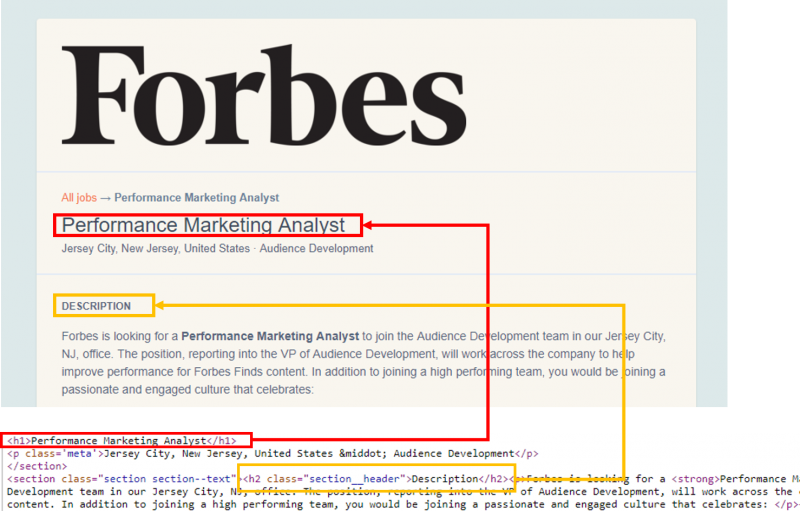
(Credit: Forbes.com )
Similarly, you can use bulleted lists to make job responsibilities and qualifications more readable:
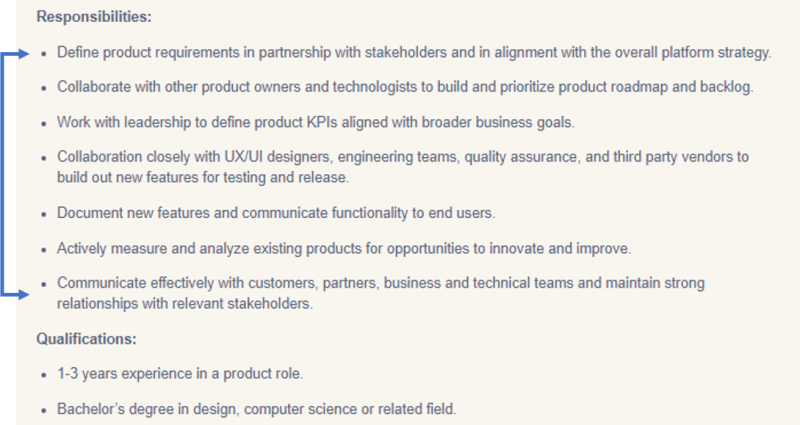
(Credit: Forbes.com )
2. Use Specific Job Titles
Some hiring managers use complex titles like “solutions architect” and “technical horticultural maintenance officer” in an attempt to spark candidates’ curiosity. Others use fun, catchy titles like “sales rock star” and “graphic designer extraordinaire” to showcase the company’s personality and capture people’s attention.
Unfortunately, job titles like these do not clearly communicate what the person in the role will have to do. Furthermore, applicants do not use these terms when searching for open roles online. They tend to use more specific terms like “financial analyst” and “interior designer” instead.
Be deliberate and specific with the job titles you use in your ads. For example, “tow truck operator” is more descriptive than “truck operator,” and “copywriter” is more concrete than “writer.” When you use specific job titles, you communicate more information to candidates. Your ad is also more likely to turn up in candidates’ searches because it uses the same terms they will be using.
It can also be helpful to include the job’s hours, e.g., “virtual assistant (part-time)” or “full-time Italian restaurant chef.” Avoid abbreviating job titles, as some abbreviations have multiple meanings. For example, “CCO” could mean “community corrections officer” or “chief compliance officer” depending on the industry.
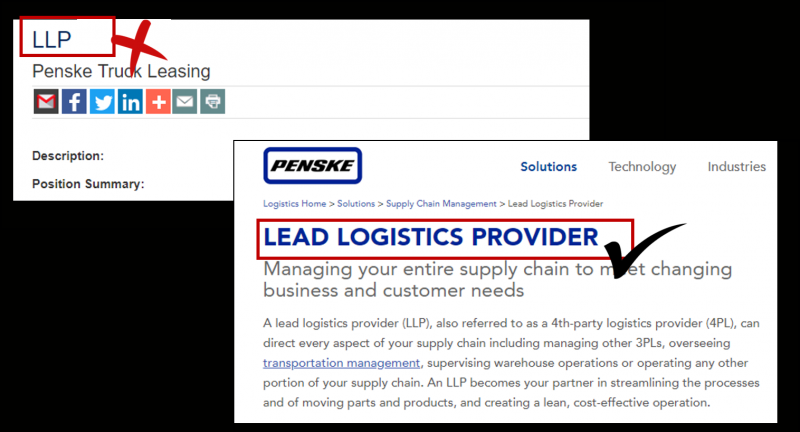
(Credit: PenskeLogistics.com )
3. Use Local SEO
Local SEO is beneficial when you are seeking applicants in close geographical proximity. When candidates are searching for jobs, they will often include their location in their searches — e.g., “writer London” or “cashier in Paddington.” If you include the job’s location in your job description, you will rank higher for searches in your local area.
4. Optimize the Title Tag
The title tag (“<title>” in HTML) indicates the title of a specific webpage. The title is what you see as the headline of a specific result on a search engine results page. In the example below, the titles of the webpages are highlighted in red boxes:

(Credit: Google )
These headlines indicate what the webpage is about, and they also serve as the searcher’s first impression of the webpage. For example, users know that when they click on “Recruiting Tips — Advice for Recruiters,” they will go to a website that shares advice on recruitment.
In terms of SEO, search engine crawlers use the title tag to determine what the webpage is about. This is why website owners often include keywords, such as locations, in the title tags of their webpages. Through those keywords, search engines gain a better understanding of the page’s relevance to users’ search queries. The more relevant your job ad is to the user’s search query, the higher it will rank in the search engine results.

(Credit: Kohls.com )
When you create a new webpage, the title you indicate for that page is automatically used as the title tag. The details you add to the title bar (see below) will also appear as the URL of the webpage.

(Credit: DigitalSearchGroup.co.uk )
5. Use Relevant Keywords and Phrases
When you include relevant keywords and phrases throughout your job ad, you increase the chances that the ad will be found when candidates search for related terms. But how do you choose the right keywords and phrases to use in your ad?
First, you need to determine the phrases that are relevant to your job description. Next, list the possible terms applicants might use when searching for your job. The job title would be the main keyword, as this is what job seekers are most likely to type into a search engine.
Let’s say you’re hiring for a content marketing specialist. “Content marketing specialist” would then be one of the key phrases to use in your job description. Indicating the location is a good idea as well. Other keywords might include tools or skills that are relevant to the job or your business. In the example below, there are key phrases that describe the company (“web marketing company” and “UK SEO agency”), the job (“content distribution” and “content outreach”), and the skills required for the job (“link-building experience” and “negotiation skills”).

(Credit: Indeed.com )
As you’re adding keywords and key phrases, be sure you aren’t overdoing it. You want to avoid “keyword stuffing,” as this can make your ad appear spammy. Use a maximum of two mentions for each keyword you add, and use variations of keywords as well. If the job ad is 500 words or less, a maximum of five keywords total is enough. If the ad is longer, you may use 7-10 keywords.
6. Indicate What Your Company Does
On all job postings, whether they’re hosted on the careers page of your website or on a third-party job board, make sure you include a brief, clear company description. Use keywords that describe your company’s function. This helps applicants understand exactly what your company does. You don’t want to give people the wrong impression of your company, as that only invites unqualified candidates to apply.

(Credit: Indeed.co.uk )
7. Give Each Job Opening Its Own Individual Page
Most companies have a careers page where they host their job postings. Each job opening should have its own individual page under the careers page. Optimize the title tags and the job descriptions on each page with relevant keywords.
If you have a unique page for every vacancy, each page will be a potential source of applicants streaming into your careers page from Google. These visits equate to more website traffic, and the more traffic your website gets, the higher your chances of ranking at the top of relevant search engine results pages.
Aside from being found more easily on search engines, unique job pages are also easier to share, which increases your reach. Just don’t forget to add social sharing buttons to each job page!
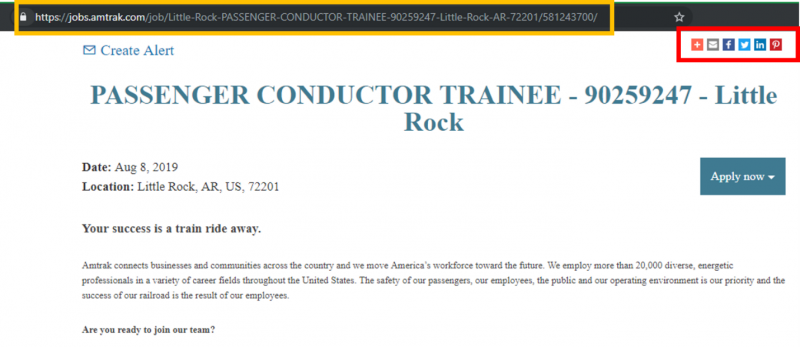
(Credit: Amtrak.com )
8. Link to Other Pages
Linking your careers page and unique job pages to other relevant sites helps you build authority for your website. A website’s authority helps search engines determine whether the website is valuable to users. The higher your site’s authority, the higher it ranks in search engine results.
Make sure your careers page contains links to other parts of your website, like your services page, your about page, and any other pages that are relevant to the job posting. This allows applicants to find more information about your company while also building webpage authority. Don’t forget to include a link to your careers page in the menu and footer of your website so that applicants can easily find all your open jobs.
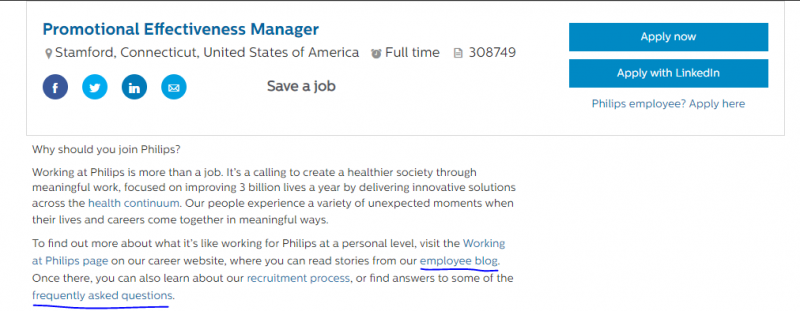
(Credit: Philips.com )
9. Share Your Job Ads
Share your job ads to your company’s social media accounts on LinkedIn, Twitter, Facebook, and elsewhere. Your followers can generate immediate traffic to your job ad, and this traffic can help increase your job listing’s rankings in search engine results pages, which in turn allows even more people to find your ad whenever they search for related terms.

(Credit: CQUniCareers )
—
Nowadays, most people use search engines like Google to look for open jobs. If you’re having a hard time attracting the attention of qualified candidates to your job ads, the best solution may be to get your SEO in order. With the tactics mentioned above, you can ensure your job listings will be found by the kinds of applicants you’re looking for.
Joe Ryan is the founder and CEO of Digital Search Group. Connect with him via email, Twitter, or LinkedIn.

